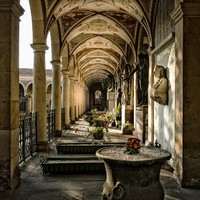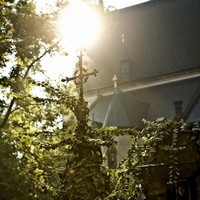Breadcrumbs navigation
The melancholy beauty of Prague’s cemeteries
An ever more popular and distinctive trend among tourists and residents is to go exploring the cemeteries. There are some eighty of them on the territory of the capital, from neglected but poetic church graveyards through the Jewish cemeteries to major burial sites of several dozen hectares. The cemeteries’ more welcoming attitude to the public goes hand in hand with the gradual transformation of their functions. They have long since ceased to be just places of piety for the bereaved, but have oft become a tourist draw, of huge cultural, historical and spiritual value.
It is no surprise then that at some Prague cemeteries you’ll find more tourists than those visiting the graves of their loved ones. Fear not – cemetery tourism has no mass appeal; the symbiosis of piety and discovering the ‘bygone world’ remains untroubled. There are several reasons why people are increasingly searching for the genius loci of Prague cemeteries. Not least, being drawn to some sort of sacred calm, rest, relaxation in the greenery, or to take pause; looking for answers to fundamental questions of life and death, the finality of being... while others perceive these places as a shrine to the nation’s collective memory, seeking out the graves and life-stories of famous personalities, or just appreciating the funerary monuments. But you’ll also find mothers pushing strollers, couples in love, photo enthusiasts or students doing their reading beneath the canopies of ancient trees.
Certainly, a most beautiful and quite mystical mood comes over the cemeteries every 2nd November, All Souls' Day (popularly called Dušičky), when people remember their deceased relatives, adorn the graves with flowers and light candles there. After dark, every necropolis glimmers with tens, hundreds, thousands of flickering lights. If you’re staying in our capital during this period and have missed Halloween, say, why not visit one of Prague’s cemeteries as a worthy alternative.
In search of ‘Saintly’ Annie
It is not easy to pick highlights among the large number of memorial sites in Prague, but let us try to cover some unmissable places. The first of these is the beautiful Malostranský Cemetery, after its recent extensive revitalization. The name itself is somewhat misleading, for it does not lie in the Lesser Town itself, but in present-day Smíchov District (Prague 5), somewhat hidden between Plzeňská and Duškova streets near the Anděl metro station. It was founded during the plague epidemic in 1680, and ceased to be a burial ground 200 years later. The charm of the ‘Lesser Town’ cemetery lies mainly in the high artistic quality of its statues, tombstones and funerary sculptures in general. Distinctive among them is undoubtedly the tombstone of kneeling Czech prince and Passau Bishop, Leopold Thun-Hohenstein, owner of the nearby Cibulka manor. Many other prominent personalities are buried here, such as the father-and-son Czech Baroque architectural duo, the Dientzenhofers, or the leading Czech painter Antonín Mánes. Surprisingly, the most famous tombstone commemorates no titan of Czech history, but is instead the 1851 tomb of Anna Degen, with a sculpture of a girl lying on a stone pedestal. Her story comes in several different versions. In perhaps the likeliest, Annie was killed accidentally when she fell out of a window; another account tells of her dying of tuberculosis at a tender age. Over the years, the stone girl has become a minor pilgrimage icon – especially for children who still believe that ‘saintly’ Annie will grant their secret wishes, and so they bring flowers, toys and pictures to the grave as a thank-you.
Prague’s Père Lachaise
Among the most popular funeral sites are the Olšany burial grounds, the largest such in Prague, covering over 50 hectares. This large rectangular expanse reminiscent of a city park is located in Prague 3 in Žižkov District and is bisected by Jana Želivského street, subdivided into a total of twelve cemeteries. It is estimated that during its existence (since 1680) some two million dead have been buried here, including numerous significant figures of Czech history.

A walk through the Olšany Cemeteries is an experience that only the most insensitive would not find touching. The seemingly endless series of manicured gravestones alternate with ancient tombs eerily covered by swathes of creeping ivy. You can also admire a number of interesting edifices in the cemetery – monuments, chapels, ceremonial halls, columbarian walls or even a compact Orthodox church. All this, perfectly enveloped in the lush greenery of mature trees. The Military burial ground, housing the mortal remains of victims of numerous European wars is undoubtedly worthy of attention. The New Jewish Cemetery in the eastern part of the grounds is a whole chapter in itself. By its size and the number of tombstones it is the largest of its kind in the Czech Republic. Here, too, many leading figures of politics, culture, science, and industry have their final resting place. Probably the most sought-out location is the tomb of writer Franz Kafka (tombstone number 21-14-21).
As already mentioned in the introduction, the progressive improvement of access to the cemeteries and public education about funeral sites quite logically brings a growing interest in the city’s burial grounds. The Olšanské Cemetery in particular is on the brink of becoming the local version of the Père Lachaise in Paris – one of the most renowned and most visited cemeteries in the world. Already, visitors here can make use of an Infocentre (with information also available in English), guided tours, small-scale exhibitions, lectures, the most famous tombstones linked by educational routes with information boards, etc.
‘The Greats’ Cemetery
Vyšehrad, with the prominently visible Basilica of Sts Peter and Paul is a magical place, firmly part of the history of Prague and the whole Czech nation. So it is no surprise that the grounds here are an oasis of quiet remembrance, commemorating Czech greats – writers, composers, actors, artists, athletes and politicians. The Vyšehrad Cemetery with its noble arcades and an unmissable landmark – the Slavín tomb – is literally a pantheon of resounding names. The composers Bedřich Smetana, Antonín Dvořák, sculptor Josef Václav Myslbek (author of the statue of St Wenceslas on the eponymous square) are buried here, alongside the writer Karel Čapek or the conductor Rafael Kubelík. This most significant place for many (not only) Prague residents is also a great ‘gallery of glory’ and a reminder of how many outstanding personalities the Czech nation has given to the world.
!!! Near the Olšany Cemeteries there is another large place of piety, in Vinohradská Street – the Vinohrady Cemetery. Buried here, among others, are the last Czechoslovak and first Czech President Václav Havel and his wife Olga.
How to get there:
Malostranský Cemetery
Metro B – Anděl stop
Tram – 9, 10, 15, 16 (Bertramka stop)
Olšany Cemeteries
Metro A – Flora or Želivského stop
Tram – 10, 11, 13, 15, 16 (Olšanské hřbitovy stop)
Tram – 26 (Mezi hřbitovy stop)
Vyšehrad Cemetery
Metro C – Vyšehrad stop
Useful information and contacts:
Cemetery opening hours (daily)
Mar–Apr 8:00–18:00
May–Sept 8:00–19:00
October 8:00–18:00
Nov–Feb 8:00–17:00
(Malostranský Cemetery daily from 9:00)
New Jewish Cemetery (daily, except Saturdays and Jewish holidays)
Nov–Mar 9:00–16:00; Fri 9:00–14:00
Apr–Oct 9:00–17:00; Fri 9:00–14:00
Tel.: + 420 272 011 126 (infocentre), E-mail: info@hrbitovy.cz
www.hrbitovy.cz; www.malostranskyhrbitov.cz; www.praha-vysehrad.cz



